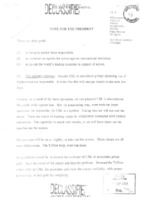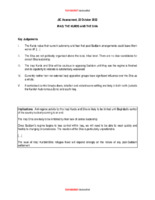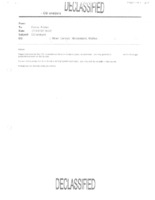Exhibits
Our Exhibits are short collections of documents (typically > 10) from our digital archive, curated by the WFTA team, to provide a quick overview of a particular theme. These would be particularly useful for students who are new to the topic or archival research. We have also included research notes and reading lists for students and researchers alongside each document within an Exhibit to highlight why these documents are important.
Correspondence from Blair to Bush Prior to the Invasion of Iraq

These notes and letters were all sent to George Bush by Tony Blair between 12 September 2001 and the invasion of Iraq in March 2003.
They have been collated to demonstrate the Blair government’s motivations for aiding Bush in the invasion of Iraq as well as to offer insight into the decision-making processes that preceded the invasion.
Whilst we only have access to the British side of correspondence, analysis of these documents aids our understanding of foreign policy and its processes as well as the gradual growth of concern regarding the security risk posed by Iraq that intensified between 2001 and 2003.
Shia Violence During the Invasion of Iraq

This group of documents discuss Shia violence during the invasion of Iraq. They consist mainly of Joint Intelligence Committee documents allowing us an insight into the intelligence available to the coalition. This allows us to understand the reactions of the coalition forces to unrest driven by religion. The sources are varied in their analysis of regions which provides us with a broad understanding of Shia tension across Iraq.
Sunni Arab Violence During the Invasion of Iraq

This collection of Joint Intelligence Committee documents discusses Sunni Arab violence following the invasion of Iraq and the removal of Saddam Hussein. Following Hussain’s removal, the predominantly Sunni government of Iraq was replaced with individuals who were coalition-friendly and predominantly Shia. This led to the growth of sectarian violence and insurgency within Iraq.
These documents allow us to trace the changing threat of Sunni Arab violence to the coalition over the course of the invasion and subsequent occupation. Furthermore, we are able to understand how and why Sunni violence posed a threat as well as why Sunni Arabs were motivated to oppose the new Iraqi regime.
The Humanitarian Situation

This collection of sources discuss the humanitarian situation in Iraq during the invasion. The sources discuss a range of topics from analysing the humanitarian situation prior to the invasion to which international actors need to provide support and aid. These sources will be useful to scholars examining human rights and the provision of aid during conflict or could provide an opportunity to examine the military’s poor planning in terms of the planning of humanitarian assistance.
